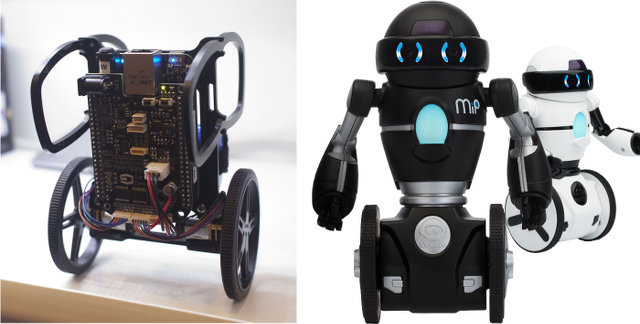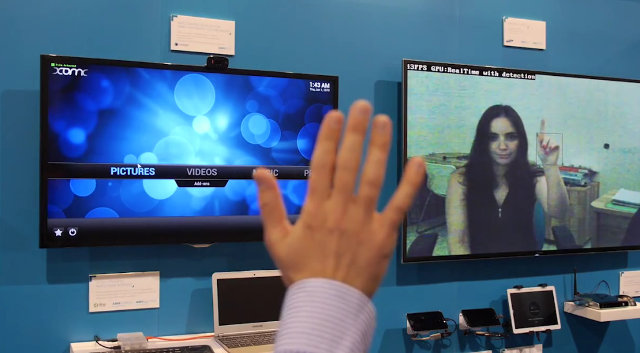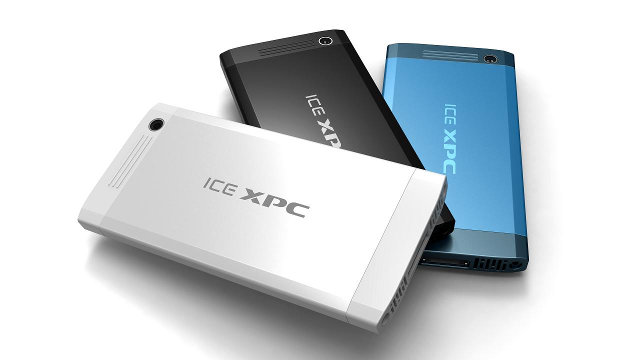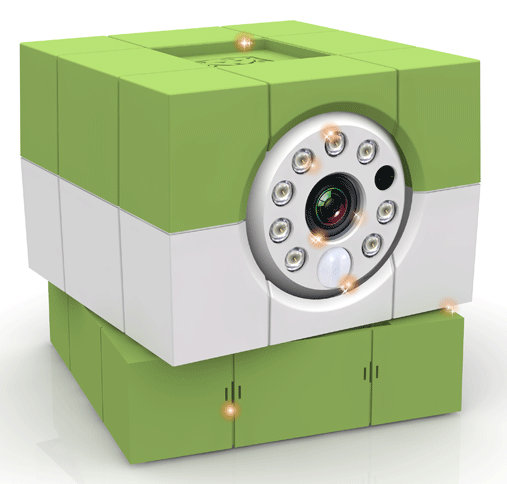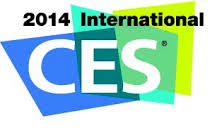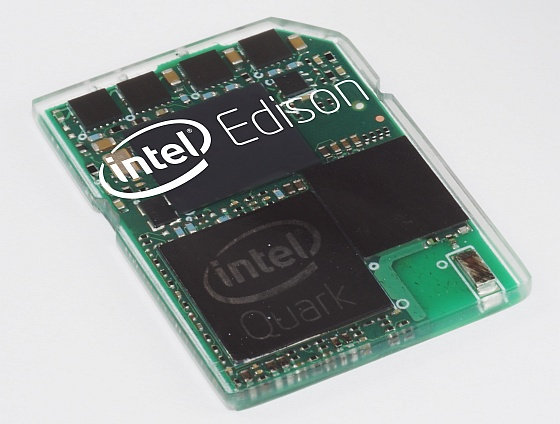In the last few days, I’ve come across three affordable open source robots either based on BeagleBone Black, or Arduino compatible boards, and I’m sure there are many other projects out there for people interested in getting started with robotics without breaking the bank. BeagleMiP Self-balancing Robot I’ve found out the first robots from a long armdevices.net video showing two Mobile Inverted Pendulum (MiP) robots, able to stand on two wheels, designed by the Coordinated Robotics Lab of The University of California, San Diego: BeagleMiP educational robotics development kit from Strawson Design. The kit features the BeagleBone Black board with Texas Instruments Sitara ARM Cortex A8 processor and Novus Robotics Cape, an add-on board that provides 9-axis IMU (Accelerometer, Gyro, Magnetometer), 6 PWM connectors to power servos or brushless ESCs, 2 user-accessible buttons and 2 LEDs, a cell balancer & overvoltage protector, H-bridges to drive 6 DC Motors, and connectors […]
ARM Mali GPU Demos at CES 2014 – 4K 3D UI and Games, ASTC Texture Compression, XBMC + Gesture Recognition, and HEVC Video Decoding
Phill Smith, Demo Manager at ARM, has filmed and uploaded four very interesting demos of what new features will be possible thanks to new generation ARM Mali-450 and Mali-T6xx GPUs including 4K 3D user interfaces and games, ASTC texture compression, and OpenCL accelerated gesture recognition and HEVC / H.265 video decoding. 4K Resolution 3D User Interface and Game Demo The first demo showcases a Geniatech box (ATV1800?) powered by AMLogic AML8726-M8 featuring an ARM Mali-450MP6 GPU running Android with a user 4K 3D interface designed by Autodesk using Scaleform UI. The rest of the video shows Timbuku 3D gaming demo running at 3840×2160 (4K2K) @ 24 fps. The frame rate appears to be low, but that’s because the box is using HDMI 1.4, which limits UHD output to 24fps. 2160p60 is only available via HDMI 2.0. ASTC Compression Demo on Samsung Galaxy Note 3 3D Textures are getting bigger and […]
ICE xPC Modular x86 Computer Is as Small as a Smartphone (Crowdfunding)
Until now, if we talked about mini PCs in stick form factor that always meant some ARM or MIPS processor were powering the devices. Intel is not yet into this type of form factor, but with ICE xPC (Indiegogo), you can now find an x86 computer module with the CPU, RAM, and SSD as well as connectivity modules and sensors into a box as small and thin as a smartphone. ICE xPC will also support other low power processors including Core i5 processor and/or ARM SoCs if the concept is gaining traction. ICE xPC modular computer specifications: SoC – Intel Bay Trail 4-cores Atom processor with Intel HD graphics System Memory – 4GB RAM Storage – 64 GB SSD Connectivity – 802.11 b/g/n Wi-Fi module + Bluetooth module Camera – 720p Sensors – Accelerometer, Gyro sensor Power Supply – 20 Watts. Energy used claimed: between 3 and 11 Watts. Dimensions […]
Amaryllo iCam HD is a Smart Wireless IP Camera Controllable via Skype
Amaryllo iCam HD is a Linux based smart network HD (720p) Camera with Wi-Fi 802.11 b/g/n + WPS connectivity, infra-red vision, 100 degrees view angle, and 360 degrees view possible via remote pan-and-tilt, a microphone, a speaker, a micro SD card slot for video recording, a motion sensor, and a micro USB port for power via a standard USB power adapter or a USB power bank. On top of that, you can easily remotely access the camera via Skype by calling from your computer or your smartphone just like you would do to call a friend or family member. The camera can be used to watch after your loved ones: babies, aging parents, pets…, and for home security. I could also envision using it with people who are close to you that are not comfortable with computers. You could just set it up for them, and call them directly without […]
CES 2014 Keynotes and Linux Conference Australia 2014 Videos
The Consumer Electronics Show and LinuxConf Australia are completely different events, the former targets consumers and takes place in the US, and the latter is for Linux users, developers & systems administrators, and occurs in Australia. However, both happened at the same time this year, and video recording for CES 2014 keynotes, and LinuxConf Australia 2014 (LCA 2014) sessions for both events are now available. CES 2014 Keynote videos While the event took place, it was quite difficult, and sometimes just impossible, to find videos of the keynotes, either live or recordings, and I could only watch Intel, Nvidia, Samsung, and Sony keynotes at the time. I’ve been informed that at least some of CES 2014 keynote videos are now available online. I can access 9 videos from Intel, Yahoo, Audi, Cisco, Sony, etc… Thanks to Csilie for the link. Linux Conference Australia 2014 LCA 2014 took place on […]
OLEDCOMM LiFi System Transforms Your LED Light Bulbs into Wireless Access Points
Oledcomm, a French startup, has designed a system based on LiFi, part of IEEE 802.15 standard, that quickly modulates your existing LED lights and deliver wireless networks in a similar manner as Wi-Fi, and delivers up to 1Gbit/s bandwidth. The modulation is fast enough so that it’s invisible to the human eye, and all your need is a LiFi enabled router that will power and transmit data to your LED lights, as well as device with a LiFi receiver, such as a LiFi enabled smartphone. Transmission is somehow bidirectional. Charbax filmed a demo by the company at CES 2014, and he seems to be in a state of disbelief during the interview, just as I did. The company did not want to provide technical details, as they are still looking for investors, but this appears to be real. In the video, they mention up to 10MB/s throughput, lower than the […]
Nvidia Tegra K1 Reference Tablet and Graphics Demo
With Tegra K1 and its Kepler GPU, Nvidia brings OpenGL 4.4, and not only OpenGL ES, to mobile devices, and the company is demo’ing OpenGL games such as Trine 2 on Tegra 4 reference tablet at CES 2014. Nvidia Tegra K1 Specifications In my initial post about Tegra K1 announcement, I missed some key features about Nvidia new processor which has now popped up on their website such as support for up to 8GB RAM, 4+1 configuration, etc and so listing a summary of the technical specifications of the 32-bit version may be useful: GPU – 192 NVIDIA CUDA cores using Kepler architecture CPU – NVIDIA 4-Plus-1 Quad-Core ARM Cortex-A15 “r3” up to 2.3 GHz Memory – DDR3L and LPDDR3, up to 8 GB with 40-bit address extension Display – LCD: Up to 3840×2160, HDMI: Up to 4K (UltraHD, 4096×2160) Package – 23×23 FCBGA, 16×16 S-FCCSP, or 15×15 FC PoP […]
Intel Unveils Edison Board for Wearables at CES 2014 Keynote
After an earlier Intel presentation about Intel RealSense Technology by Mooly Eden, Intel Senior Vice President and General Manager, the newly appointed Intel CEO, Brian Krzanich, officially opened CES 2014 with the pre-show keynote. This time there was nothing about processors for PCs, and the announcement the most interesting and relevant to this blog was Intel Edison, a tiny SD-card sized board powered by a dual core Quark SoC. Specifications: SoC – Unnamed and new dual core Intel Quark SoC @ 400MHz manufactured with 22nm process technology. MCU – Unnamed Intel MCU (MCS 51??) to manage I/Os and other baseline functions. System Memory – LPDDR2 Storage – NAND Flash Connectivity – Wi-Fi and Blutooth 4.0 LE Dimensions – Just like an SD card The board will support Linux, and common open source tools used by the marker community. It will also support Wolfgram language and Mathematica. There will also be […]


